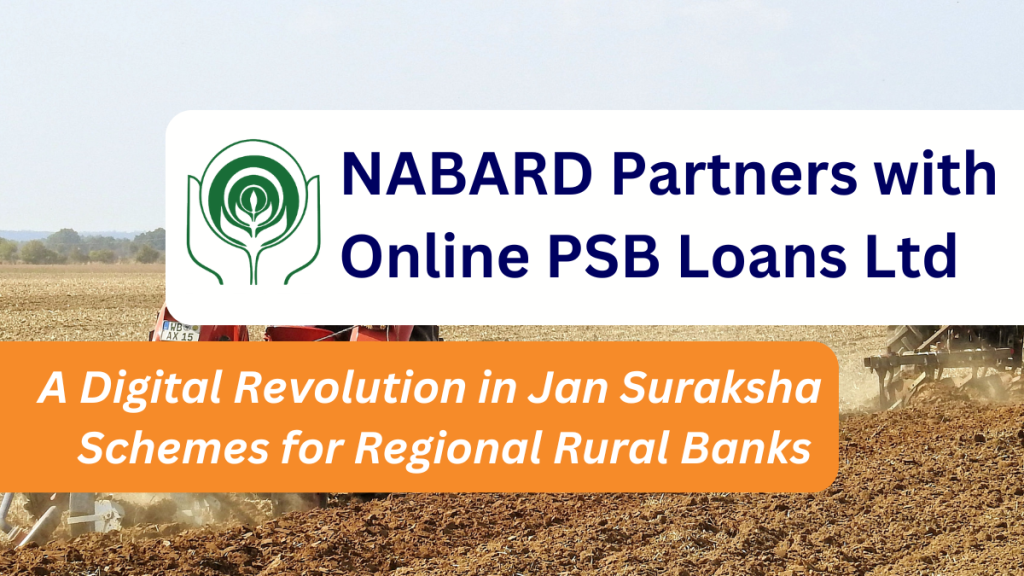To improve financial inclusion and reduce the gap between urban and rural areas, NABARD has partnered with Online PSB Loans Ltd. to digitize Jan Suraksha Schemes for RRBs. This collaboration is more than just a move towards accepting technology, it’s a big stride in making sure that social security programs reach all remote areas of rural India, where they are urgently required.
This partnership serves as an ideal example for students and future finance professionals on how the combination of technology and policy can collaborate to promote inclusive growth. This blog will examine the functions of NABARD and Online PSB Loans Ltd., the significance of Jan Suraksha Schemes, and the potential impact of this collaboration on rural banking in India.

NABARD: The Pillar of Rural Development
Established on July 12, 1982, by Indian Parliament legislation, NABARD is India’s main development bank, focused on increasing credit accessibility to promote the development of agriculture, small industries, cottage industries, and rural crafts. NABARD’s primary objective is to enhance rural India by offering financial and non-financial assistance.
Over the years, NABARD has played a key role in the progress of rural areas both socially and economically. It has been at the forefront in carrying out various government initiatives aimed at decreasing poverty, enhancing agricultural efficiency, and improving rural regions. NABARD ensures that financial services are accessible to remote areas of the country by supporting regional rural banks (RRBs) and cooperative banks.
NABARD not only offers financial assistance but also acts as a policy maker and provides expert guidance to rural financial institutions. It also monitors the implementation of government programs to ensure they achieve goals successfully.
The Vital Jan Suraksha Schemes: A Lifeline for Rural India
To offer a safety cushion for all members of society, particularly those in non-formal employment, the Indian Government implemented the Jan Suraksha Schemes. These programs target offering inexpensive insurance and retirement benefits to economically disadvantaged members of the community. Now, we will examine the three main programs included in the Jan Suraksha initiative:
- Pradhan Mantri Suraksha Bima Yojana (PMSBY): This is an accidental insurance scheme that offers coverage against death or disability due to an accident. With a meager premium of ₹12 per annum, it provides a sum insured of ₹2 lakh for accidental death and full disability, and ₹1 lakh for partial disability.
- Pradhan Mantri Jeevan Jyoti Bima Yojana (PMJJBY): This life insurance scheme is designed to offer coverage for death due to any cause. It is available to individuals aged 18 to 50 years, with a yearly premium of ₹330. The scheme provides a life cover of ₹2 lakh, making it an affordable and essential security measure for the economically weak.
- Atal Pension Yojana (APY): Targeted at workers in the unorganized sector, the APY encourages people to save for their retirement. The scheme guarantees a minimum monthly pension of ₹1,000 to ₹5,000, depending on the contribution made, starting at the age of 60. It promotes a culture of saving for old age among people who do not have access to formal pension systems.
These schemes are not just about financial security; they represent the government’s commitment to ensuring that every citizen, regardless of their economic status, has access to basic social security.
Overview of Jan Suraksha Schemes:
| Scheme Name | Coverage | Eligibility | Annual Premium | Benefits |
| Pradhan Mantri Suraksha Bima Yojana (PMSBY) | Accidental death and disability insurance | Individuals aged 18-70 years | ₹12 | ₹2 lakh for accidental death, ₹1 lakh for partial disability |
| Pradhan Mantri Jeevan Jyoti Bima Yojana (PMJJBY) | Life insurance (death due to any cause) | Individuals aged 18-50 years | ₹330 | ₹2 lakh on death due to any cause |
| Atal Pension Yojana (APY) | Pension after the age of 60 | Individuals aged 18-40 years | Variable based on contribution | Guaranteed pension of ₹1,000 to ₹5,000 per month |
Regional Rural Banks (RRBs): The Backbone of Rural Banking
Regional Rural Banks were founded in 1976 through the RRB Act to offer adequate banking and credit services to rural and semi-urban regions. RRBs are vital in fulfilling the credit requirements of small and marginal farmers, artisans, and agricultural laborers. They play a vital role in distributing loans and carrying out government programs aimed at rural communities.
Although important, RRBs encounter various challenges such as minimal technological support, shortage of staff, and struggles in accessing distant locations. These obstacles can impede their ability to efficiently provide services and execute initiatives such as the Jan Suraksha Schemes.
Potential Benefits of Digitalization in Rural Banking:
| Benefit | Description | Impact on RRBs and Customers |
| Increased Accessibility | Digital platforms bridge the gap between rural customers and banking services. | Easier access to financial products, even in remote areas. |
| Improved Efficiency | Automation of banking processes reduces time and operational costs. | Faster service delivery and reduced administrative workload. |
| Enhanced Transparency Better Customer Experience | Digital systems minimize errors and fraud through transparent operations. 24/7 access to banking services through mobile and internet banking platforms. | Increased trust and reliability in banking services. Improved customer satisfaction and convenience. |
| Wider Coverage of Schemes | Simplified enrollment process for Jan Suraksha Schemes. | More rural customers benefiting from insurance and pension schemes. |
| Empowerment of RRBs | Technological advancements position RRBs to compete with larger banks. | Improved performance and sustainability of RRBs. |
The Digitalization Imperative in Rural Banking
The collaboration between NABARD and Online PSB Loans Ltd. is an inventive and visionary move to change the rural banking scenario in India. This project seeks to make Jan Suraksha Schemes more accessible to those in need, using digital technology to make certain that social security is not just for a few, but a right for everyone.
For RRBs, digitalization can:
- Improve Accessibility: Digital podiums can connect rural customers to banking services without the need to visit a physical branch. Mobile and internet banking can make it easier for people in remote areas to access financial products.
- Improve Operational Efficiency: Automating processes can reduce the time and cost associated with traditional banking methods. This efficiency can be particularly beneficial for RRBs, which often operate with limited resources.
- Increase Transparency: Digital records reduce the risk of errors and fraud, ensuring that transactions are transparent and traceable. This is especially important in the context of government schemes, where accountability is essential.
- Boost Customer Experience: Digital banking podiums can provide a more user-friendly experience, offering customers 24/7 access to their accounts, faster transactions, and a wider range of services.
The Partnership: A Strategic Move by NABARD and Online PSB Loans Ltd.
NABARD’s partnership with Online PSB Loans Ltd. is a landmark development in the digitalization of rural banking. Online PSB Loans Ltd. is a fintech company specializing in providing digital platforms for lending and financial services, particularly focusing on MSMEs (Micro, Small, and Medium Enterprises). Their expertise in digital technology makes them the ideal partner for NABARD in this ambitious project.
Here are the key components of this partnership:
- User-Friendly Digital Platforms: The collaboration will focus on developing a digital platform that is easy to use, even for those with limited technological know-how. This platform will allow RRBs to seamlessly enroll customers in the Jan Suraksha Schemes, manage their accounts, and assure timely disbursement of benefits.
- Training and Capacity Building: One of the critical aspects of this partnership is the emphasis on training. NABARD and Online PSB Loans Ltd. will conduct training programs for RRB staff to equip them with the skills needed to operate the new digital platforms. This training will cover everything from basic digital literacy to advanced data management techniques.
- Outreach and Awareness Campaigns: Digital podium alone is not enough; the success of this initiative depends on widespread adoption by rural customers. To this end, NABARD will work with RRBs to conduct outreach programs aimed at educating rural populations about the benefits of digital banking and how they can use these podiums to access the Jan Suraksha Schemes.
- Robust Data Management Systems: The partnership will also focus on developing secure and efficient data management systems. These systems will confirm that customer data is stored safely, easily accessible when needed, and protected against cyber threats. This will improve the efficiency of service delivery and improve customer trust in digital banking.
Transforming Rural Banking: The Potential Impact
The digitalization of Jan Suraksha Schemes through NABARD’s partnership with Online PSB Loans Ltd. is poised to revolutionize rural banking in India. Here’s how:
- Wider Coverage: By simplifying the process of enrolling in Jan Suraksha Schemes, the digital platform will make it easier for RRBs to reach more people. This will increase the coverage of these schemes, ensuring that more rural customers benefit from affordable insurance and pension plans.
- Enhanced User Experience: The digital platform will allow customers to manage their insurance and pension plans from the comfort of their homes. They can check their policy status, make premium payments, and even file claims online, eliminating the need to visit a bank branch.
- Increased Efficiency: Digitalization will significantly reduce the administrative workload for RRBs. By automating processes, RRBs can focus more on customer service and less on paperwork, leading to quicker and more accurate service delivery.
- Boost to Financial Inclusion: By making Jan Suraksha Schemes more accessible, this effort will bring more people into the formal financial system. This is an essential step toward achieving the goal of financial inclusion, ensuring that even the most marginalized sections of society have access to essential financial services.
- Empowerment of RRBs: With the technological support provided by Online PSB Loans Ltd., RRBs will be better positioned to compete with larger commercial banks. They will be able to offer a wider range of services, improve their operational efficiency, and ultimately improve their financial sustainability.
Challenges and the Road Ahead
While the benefits of this partnership are substantial, there are challenges that must be addressed to assure its success:
- Digital Literacy: A significant portion of the rural population may lack the digital literacy required to use online banking platforms. Intensive education and awareness campaigns will be needed to confirm that customers can effectively use the new digital tools.
- Infrastructure Limitations: While mobile and internet penetration in rural areas has improved, there are still regions with poor connectivity. The success of this effort depends on the ability to provide reliable digital services in these areas.
- Data Security: As the use of digital platforms increases, so does the risk of cyber threats. Ensuring robust cybersecurity measures and safeguarding customer data will be paramount.
- Sustainability of Digital Platforms: The long-term success of this effort depends on the ability of RRBs to maintain and sustain the digital platforms. Continuous technical support and updates will be necessary to keep the platforms running smoothly.
Conclusion: A New Era in Rural Banking
The collaboration between NABARD and Online PSB Loans Ltd. is an innovative and visionary move to change the rural banking scenario in India. This project seeks to make Jan Suraksha Schemes more accessible to those in need, using digital technology to make certain that social security is not just for a few, but a right for everyone.
This indicates the future of banking in India for students and professionals in the financial industry. It will be essential for individuals interested in making a difference in rural finance to grasp these trends and the difficulties they bring.
It is important to acknowledge the larger impact on financial inclusion, rural development, and economic growth in India as we witness this partnership progress. Navigating the upcoming challenges may be difficult, yet by implementing the appropriate tactics, this project has the potential to drive rural banking forward into the digital era, guaranteeing inclusivity for all.
You can make a rewarding career in NABARD by preparing effectively for its competitive exams, which are known for their precise selection process. To succeed, staying updated with the latest NABARD Grade A notifications, understanding the NABARD grade A exam pattern, and practicing regularly with mock tests is important. For detailed preparation, platforms like iXamBee offer specialized NABARD Grade A mock tests, detailed exam analysis, and expert guidance to help you excel. The NABARD exam pattern typically includes sections on reasoning, quantitative aptitude, English language, general awareness, and professional knowledge, all of which can be mastered with the right resources and consistent practice through iXamBee’s customized study plans.
To help you prepare 50% faster for competitive exams, ixamBee provides free Mock Test Series and all the Current Affairs in English and Current Affairs in Hindi in the BeePedia capsules for GA Preparation. You can also get the latest updates for Bank PO, Bank Clerk, SSC, RBI Grade B, NABARD, and Other Government Jobs.
Also read
Preparation Strategy for NABARD GRADE A Prelims Exam
How To Prepare for NABARD Grade A Mains Exam
RBI Grade B 2024: Expected Exam Dates, Eligibility, Exam Pattern & More.















